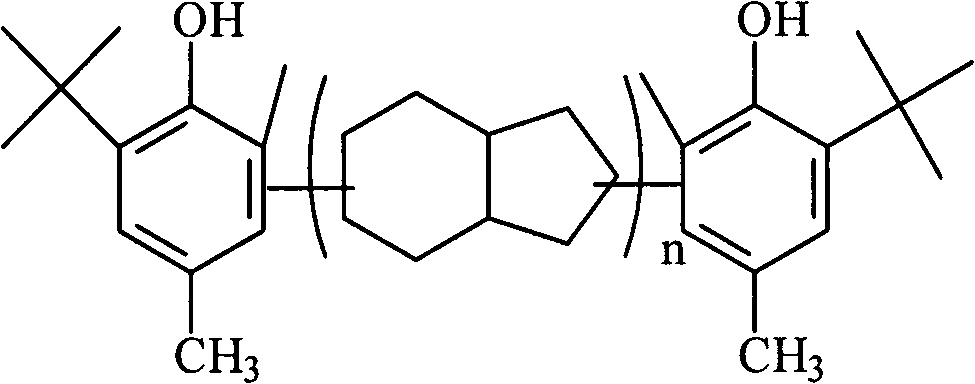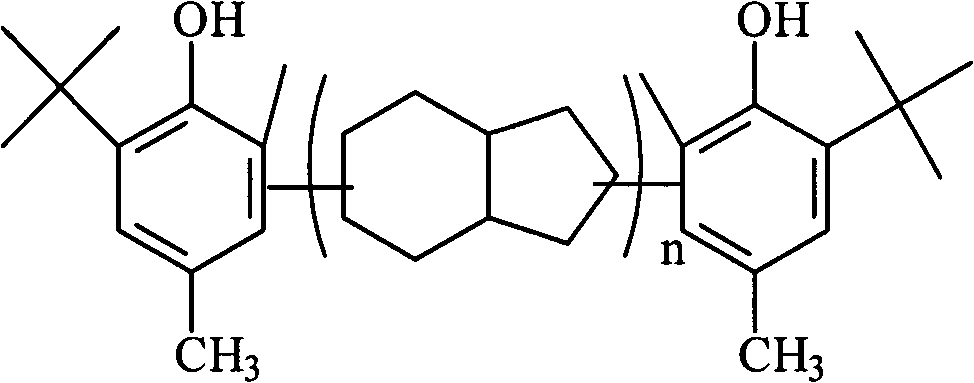Preparation method for polymerization-type asymmetric hindered phenol anti-oxidant resins
A technology of asymmetric hindered phenols and antioxidants, which is applied in the synthesis field of polymerized asymmetric hindered phenolic antioxidant resins, can solve the problems of poor antioxidant activity and thermal stability of antioxidants, synthesis process pollution, etc., and achieve Good anti-oxidation effect, simple and safe process, good extraction resistance effect
- Summary
- Abstract
- Description
- Claims
- Application Information
AI Technical Summary
Problems solved by technology
Method used
Image
Examples
Embodiment 1
[0018] In a 500ml reactor equipped with a stirrer, reflux condenser, feeding device and nitrogen protection device, add 80g toluene, 100g p-cresol, 18g strong acid resin catalyst, replace with nitrogen, heat to 83 ° C, drop Dicyclopentadiene 112g, dropwise time 60min, after dropwise addition, heat up to 105°C, after 3.5h reaction, add phosphoric acid 1.0g, alkylation catalyst 12g, reaction temperature 75°C, dropwise add methanol and isobutanol 32g of mixed raw materials with a ratio of 3:7, adding time for 40 minutes, reacting for 2 hours after the dropping, filtering to remove the resin catalyst after the reaction, washing with alkali and water until neutral, stripping with water vapor to remove oligomers, solvents and The unreacted raw materials were distilled to 218°C under reduced pressure, and 161 g of the product was obtained after cooling, and the calculated product yield was 87.98%. The product is a brown resin, its molecular weight is 770-850 as determined by GPC, and...
Embodiment 2
[0020] In a 500ml reactor equipped with a stirrer, reflux condenser, feeding device and nitrogen protection device, add 100g toluene, 100g p-cresol, 26g strong acid resin catalyst, replace with nitrogen, heat to 80°C, drop Dicyclopentadiene 140g, dropwise time 42min, after dropwise addition, heat up to 110°C, after 3.5h reaction, add phosphoric acid 1.2g, alkylation catalyst 20g, reaction temperature 80°C, dropwise add methanol and isobutanol 40g of mixed raw materials with a ratio of 3:7, adding time of 40 minutes, reacting for 2 hours after the dropping, filtering to remove the resin catalyst after the reaction, washing with alkali and water until neutral, stripping with water vapor to remove oligomers, solvents and The unreacted raw materials were distilled to 247°C under reduced pressure, and 177g of the product was obtained after cooling, and the calculated product yield was 90.36%. The product is a brown resin, its molecular weight determined by GPC is 860-970, and its s...
Embodiment 3
[0022] In a 500ml reactor equipped with a stirrer, reflux condenser, feeding device and nitrogen protection device, add 80g toluene, 100g p-cresol, 20g strong acid resin catalyst, replace with nitrogen, heat to 90°C, drop Dicyclopentadiene 117g, dropwise time 60min, after dropwise addition, heat up to 102°C, after reaction for 4h, add phosphoric acid 1.6g, alkylation catalyst 22g, reaction temperature 86°C, dropwise add ethanol and isobutanol molar ratio 36g of mixed raw materials of 5:5, the dropping time is 40min, the reaction is 2.5h after the dropwise addition, the resin catalyst is removed by filtration after the reaction is completed, and after alkali washing and water washing to neutrality, the oligomers, solvent and The unreacted raw material was distilled to 233°C under reduced pressure, and 173 g of the product was obtained after cooling, and the calculated product yield was 90.22%. The product is a brown resin with a molecular weight of 740-900 and a softening point...
PUM
| Property | Measurement | Unit |
|---|---|---|
| softening point | aaaaa | aaaaa |
| softening point | aaaaa | aaaaa |
| softening point | aaaaa | aaaaa |
Abstract
Description
Claims
Application Information
 Login to View More
Login to View More - R&D
- Intellectual Property
- Life Sciences
- Materials
- Tech Scout
- Unparalleled Data Quality
- Higher Quality Content
- 60% Fewer Hallucinations
Browse by: Latest US Patents, China's latest patents, Technical Efficacy Thesaurus, Application Domain, Technology Topic, Popular Technical Reports.
© 2025 PatSnap. All rights reserved.Legal|Privacy policy|Modern Slavery Act Transparency Statement|Sitemap|About US| Contact US: help@patsnap.com


